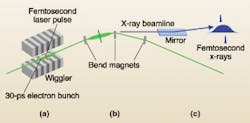FEMTOSECOND IMAGING: Synchrotron produces ultrafast pulses
For those of us who remember the days when 35-mm cameras required manual exposure settings, one of the main tricks of capturing an image on that other soon-to-be anachronism, film, was to correctly negotiate the trade-off between shutter speed and depth of field. The bottom line was that you couldn't have both. Well, the bottom line has gotten fuzzier with progress, not only with hand-held cameras, but also with femtosecond imaging of atomic particles.
Last March, researchers at the US Department of Energy's Lawrence Berkeley National Laboratory (LBNL; Berkeley, CA), working at the lab's Advanced Light Source (ALS), extracted femtosecond pulses of synchrotron light directly from the electron beam in the synchrotron's storage ring.1 Synchrotron pulses narrower than 300 fs were produced from the primary beam of the synchrotron light source with a spectral range extending from infrared to x-ray wavelengths.
Straightforward refinements to the technique are currently underway and are expected to yield 100-fs x-rays by this summer. Ultimately, the technique is expected to provide scientists with a stop-action x-ray camera that can capture the motion of atoms during physical, chemical, and biological reactions. Just aim and shoot.
Currently, atomic motion and rearrangement (also known as ultrafast structural dynamics) are primarily investigated using visible pulses from modelocked femtosecond lasers, which provide the "shutter speed" necessary to handle the atomic vibrational period on the order of 100 fs, but can only probe the extended electronic states of the atomic dynamics. X-rays, on the other hand, provide the "depth-of-field" needed to interact with core electronic levels, but have lacked the "shutter speed" until now.
Lead investigator Robert Schoenlein and his colleagues produced the femtosecond pulses by pumping the ALS electron beam with a femtosecond optical laser pulse by way of a "wiggler" insertion device (see figure). Wigglers are magnetic arrays with alternating north and south poles that vibrate electrons in the beam and cause them to emit energy in the form of light. Under the right conditions, the simultaneous presence of a pulse of laser light will modulate some of these energy emissions.
In this experiment, the modulation enabled an ultrashort slice of electrons in the beam to be spatially separated from the rest of the electron bunches in the ALS beam. When the displaced electron slice was then sent through a bend magnet, it generated its own light. Theoretically, this light should have appeared at about the same femtosecond pulse length as the laser light that created it. However, time-of-flight effects due to the distance between the wiggler and the bend magnet resulted in pulses of about 300 fs.
Straightforward modifications to the device to further improve performance are underway. One-hundred-femtosecond pulses should arrive this summer with the completion of a project to place the bend magnets closer to the wiggler. Higher-brightness beams are also in the offing with a plan to ultimately replace the bend magnets with a magnet array device (an undulator). Unlike a bend magnet, which produces sweeping beams of light, like that from a beacon, undulator light is more like the beam from a laser, highly coherent and tunable to a specific wavelength—point and click.
The scheme for generating femtosecond pulses directly from a synchrotron was originally conceived by Alexander Zholents and Max Zolotorev, of LBNL's Center for Beam Physics (CBP), who are also members of the research team. Other team members are Berkeley Lab director and femtosecond spectroscopy pioneer Charles Shank, Swapon Chattopadhyay of the CBP, Thornton Glover and Philip Heimann of the ALS, and H. H. W. Chong, a graduate student at the University of California at Berkeley.
Schoenlein, Zolotorev, and Glover were also members of a Berkeley Lab research team that in 1996 produced the first directed beams of femtosecond x-rays. This earlier work was also done at the ALS but on a branch beamline off the 50-MeV (million electron volt) linear accelerator that feeds electrons into the ALS booster synchrotron. The latest femtosecond pulses were produced within the storage ring, which provides a much higher flux and brightness.
The ALS is an electron synchrotron designed to accelerate electrons to energies of 1.9 GeV (billion electron volts) and hold them for several hours in a tightly constrained beam inside a storage ring approximately 200 m in circumference (660 ft). As the electron beam circles through this storage ring, beams of ultraviolet and low energy or "soft" x-ray light can be siphoned off from it through the use of either bend, wiggler, or undulator magnetic devices. This light, which can be used for a wide variety of scientific applications, is on the order of a hundred million times brighter than the light from the most powerful x-ray tubes. Hmmmm. They could probably make one heck of a flash bulb if they put their minds to it.
REFERENCE
- R. W. Schoenlein et al., Science 287, 2237 (March 24, 2000).
About the Author
Hassaun A. Jones-Bey
Senior Editor and Freelance Writer
Hassaun A. Jones-Bey was a senior editor and then freelance writer for Laser Focus World.
